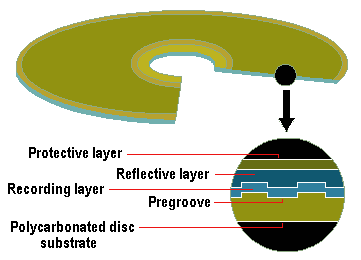
Why use Dyes at all?
The first attempts to create recordable CDs were based around metal alloy layers which were designed to melt under the harsh conditions of laser irradiation. Short pulses were used to make sure that no significant thermal conductance occured and that the melting was therefore very localised. The melting lead to bubble formation and flow of molten metal. However, the laser pulses were short and the layer cooled rapidly, setting the pits and lands permanently into the active layer. This technology had the advantage of high reflectivity and hence good compatability with standard CD-ROM drives. Unfortunately however, the discs were expensive and the lasers used for writing consumed a lot of power and were dangerous.
However, dye molecules can be made to perform a very similar function. If an organic molecule is irradiated by the correct frequency of light, it will undergo an electronic transition. For conjugated systems such as the methine or cyanine dyes, a simple particle in a box model will give an estimate of the absorption frequency. For cyclic systems the problem is more complex. On absorption, the excited state of the molecule relaxes to the ground state by a variety of vibrational, rotational and translational transitions, all resulting in increased thermal energy. Organic dye compounds often exhibit low thermal conductivities, so the heat generated by the intense absorption of monochromatic light cannot dissapate. The results can be melting, vaporisation or even decomposition of the dye in a very well defined locus.
The result of this change is in the optical properties of the dye, causing a simulated pit effect. These pits tend to be less well defined than those in metal CDs and give a lower reflectivity difference between "pit" and "land". This can lead to difficulties with reading the media in older drives. Dyes do however, confer several other advantages, as they are mainly non-toxic, cheap to produce, chemically and thermally stable. The reflectivity issue is often overcome by placing a layer of reflective material such as gold or silver behind the dye layer, giving the common green colour of many CD-Rs.(Blue dye on gold looks green!).

The structure of a CD-R with dye and reflector.